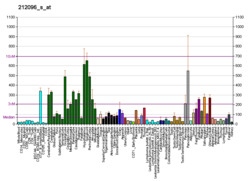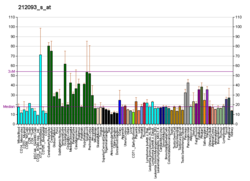Mitochondrial tumor suppressor 1 (MTSG1) or Microtubule-Associated Scaffold Protein 1 (MTUS1) is a candidate tumor suppressor protein encoded by the MTUS1 gene in humans.[5][6] Expression levels of MTUS1 was reported to be lost in various types of human malignancies such as colon, ovarian, head-and-neck, pancreas, breast cancers, bladder, gastric, and lung cancers.[7][8]
Proteins encoded by MTUS1[edit]
As a result of alternative splicing MTUS1 was shown to encode 5 different protein isoforms as listed as ATIP1, ATIP2, ATIP3a, ATIP3b and ATIP4. ATIP3a and ATIP3b was generally considered as ATIP3 and ATIP1 and ATIP3 is the major splice variants encoded by MTUS1 gene.[9]
Function[edit]
This gene encodes a protein which contains a C-terminal domain able to interact with the angiotensin II receptor type 2 (AT2) and a large coiled-coil region allowing dimerization. Multiple alternatively spliced transcript variants encoding different isoforms have been found for this gene. One of the transcript variants has been shown to encode a mitochondrial protein that acts as a tumor suppressor and participates in AT2 signaling pathways. Other variants may encode nuclear or transmembrane proteins but it has not been determined whether they also participate in AT2 signaling pathways.[10]
Interactions[edit]
MTUS1 has been shown to interact with Angiotensin II receptor type 2.[11]
References[edit]
- ^ a b c GRCh38: Ensembl release 89: ENSG00000129422 – Ensembl, May 2017
- ^ a b c GRCm38: Ensembl release 89: ENSMUSG00000045636 – Ensembl, May 2017
- ^ "Human PubMed Reference:". National Center for Biotechnology Information, U.S. National Library of Medicine.
- ^ "Mouse PubMed Reference:". National Center for Biotechnology Information, U.S. National Library of Medicine.
- ^ Kara M, Kaplan M, Bozgeyik I, Ozcan O, Celik OI, Bozgeyik E, Yumrutas O (August 2016). "MTUS1 tumor suppressor and its miRNA regulators in fibroadenoma and breast cancer". Gene. 587 (2): 173–7. doi:10.1016/j.gene.2016.05.006. PMID 27155522.
- ^ Bozgeyik I, Yumrutas O, Bozgeyik E (August 2017). "MTUS1, a gene encoding angiotensin-II type 2 (AT2) receptor-interacting proteins, in health and disease, with special emphasis on its role in carcinogenesis". Gene. 626: 54–63. doi:10.1016/j.gene.2017.05.019. PMID 28499941.
- ^ Bozgeyik I, Yumrutas O, Bozgeyik E (August 2017). "MTUS1, a gene encoding angiotensin-II type 2 (AT2) receptor-interacting proteins, in health and disease, with special emphasis on its role in carcinogenesis". Gene. 626: 54–63. doi:10.1016/j.gene.2017.05.019. PMID 28499941.
- ^ Ozcan O, Kara M, Yumrutas O, Bozgeyik E, Bozgeyik I, Celik OI (May 2016). "MTUS1 and its targeting miRNAs in colorectal carcinoma: significant associations". Tumour Biology. 37 (5): 6637–45. doi:10.1007/s13277-015-4550-4. PMID 26643896. S2CID 25574850.
- ^ Bozgeyik I, Yumrutas O, Bozgeyik E (August 2017). "MTUS1, a gene encoding angiotensin-II type 2 (AT2) receptor-interacting proteins, in health and disease, with special emphasis on its role in carcinogenesis". Gene. 626: 54–63. doi:10.1016/j.gene.2017.05.019. PMID 28499941.
- ^ "Entrez Gene: MTUS1 mitochondrial tumor suppressor 1".
- ^ Nouet S, Amzallag N, Li JM, Louis S, Seitz I, Cui TX, Alleaume AM, Di Benedetto M, Boden C, Masson M, Strosberg AD, Horiuchi M, Couraud PO, Nahmias C (July 2004). "Trans-inactivation of receptor tyrosine kinases by novel angiotensin II AT2 receptor-interacting protein, ATIP". The Journal of Biological Chemistry. 279 (28): 28989–97. doi:10.1074/jbc.M403880200. PMID 15123706.
Further reading[edit]
- Di Benedetto M, Pineau P, Nouet S, Berhouet S, Seitz I, Louis S, Dejean A, Couraud PO, Strosberg AD, Stoppa-Lyonnet D, Nahmias C (June 2006). "Mutation analysis of the 8p22 candidate tumor suppressor gene ATIP/MTUS1 in hepatocellular carcinoma". Molecular and Cellular Endocrinology. 252 (1–2): 207–15. doi:10.1016/j.mce.2006.03.014. PMID 16650523. S2CID 19420252.
- Frank B, Bermejo JL, Hemminki K, Sutter C, Wappenschmidt B, Meindl A, Kiechle-Bahat M, Bugert P, Schmutzler RK, Bartram CR, Burwinkel B (July 2007). "Copy number variant in the candidate tumor suppressor gene MTUS1 and familial breast cancer risk". Carcinogenesis. 28 (7): 1442–5. doi:10.1093/carcin/bgm033. PMID 17301065.
- Di Benedetto M, Bièche I, Deshayes F, Vacher S, Nouet S, Collura V, Seitz I, Louis S, Pineau P, Amsellem-Ouazana D, Couraud PO, Strosberg AD, Stoppa-Lyonnet D, Lidereau R, Nahmias C (October 2006). "Structural organization and expression of human MTUS1, a candidate 8p22 tumor suppressor gene encoding a family of angiotensin II AT2 receptor-interacting proteins, ATIP". Gene. 380 (2): 127–36. doi:10.1016/j.gene.2006.05.021. PMID 16887298.
- Nouet S, Amzallag N, Li JM, Louis S, Seitz I, Cui TX, Alleaume AM, Di Benedetto M, Boden C, Masson M, Strosberg AD, Horiuchi M, Couraud PO, Nahmias C (July 2004). "Trans-inactivation of receptor tyrosine kinases by novel angiotensin II AT2 receptor-interacting protein, ATIP". The Journal of Biological Chemistry. 279 (28): 28989–97. doi:10.1074/jbc.M403880200. PMID 15123706.






